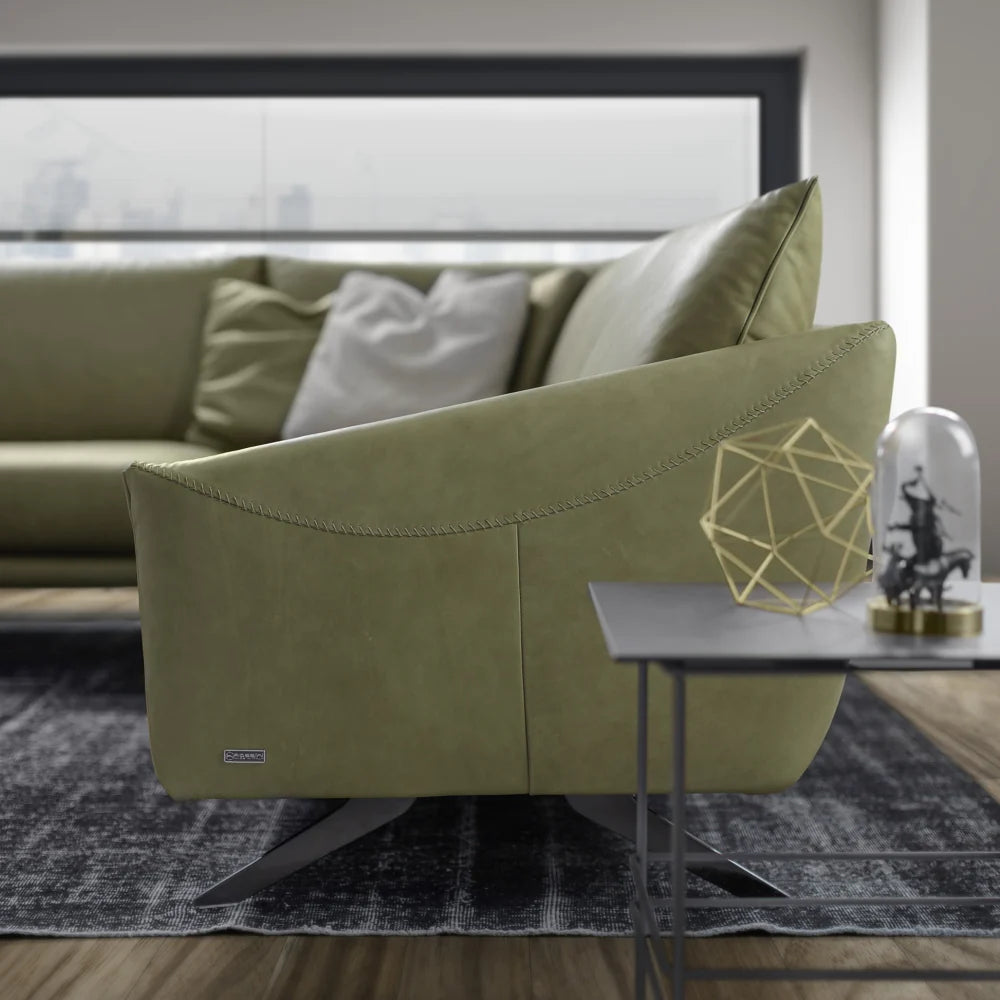The exploration of Italian leather durability leads to common questions: “Does Italian leather peel?, “Is Italian leather durable?”. Unveiling the intricacies of this query is crucial for those seeking the pinnacle of quality in leather products. Renowned for its exquisite craftsmanship and timeless allure, Italian leather has earned a reputation synonymous with luxury.
This investigation into the durability of Italian leather delves into whether the concern of peeling, a common issue in some leathers, holds true for this prestigious tradition. Understanding the nuances of Italian leather quality is pivotal, unraveling the fabric of its enduring legacy and offering insights into the factors that contribute to its resilience and long-lasting elegance.
Does Real Leather Peel?
Real leather rarely peels, but neglect and daily use without proper care can harm it. Peeling may stem from other factors, and excessive cleaning with the wrong products can worsen the issue. To maintain the pristine condition of your leather jacket or furniture, understanding leather maintenance is crucial. Consider the specific type of leather, its unique qualities, and choose appropriate cleaning agents. Remember, not all leathers are equal, so the care for your jacket will differ from that of your leather shoes. Stay informed to ensure longevity and a fresh appearance for your cherished leather items.
What Causes Leather Peeling?
Low-Quality Or Bonded Leather
Low-Quality Or Bonded Leather
Leather peeling can be attributed to various factors, each shedding light on the importance of proper care and maintenance. Low-quality or bonded leather stands out as a primary culprit. Unlike genuine Italian leather, which is celebrated for its durability, bonded leather consists of leather scraps glued together, making it prone to peeling when exposed to wear and tear. Understanding the distinction between authentic Italian leather, known for its longevity, and bonded leather is crucial in preventing peeling issues.

Dryness And Lack Of Moisture
Dryness and lack of moisture also contribute to leather peeling. Genuine leather, including Italian leather, requires adequate hydration to maintain its suppleness. Without proper moisturization, the leather can dry out, leading to cracks and eventual peeling. Italian leather care often involves the use of specialized creams to nourish and protect the material, preventing dryness-related damage.
Exposure To Sunlight And Heat
Exposure to sunlight and heat can accelerate the peeling process. Prolonged exposure to these elements can cause Italian leather to lose its natural oils and become brittle, making it susceptible to peeling. Protective measures, such as keeping leather items away from direct sunlight and excessive heat, can help preserve their integrity.

Harsh Cleaning Products
The use of harsh cleaning products poses another risk. Italian leather, when subjected to abrasive chemicals, may suffer damage, including peeling. Adopting gentle cleaning methods and using products specifically designed for Italian leather care is essential to avoid deterioration.
Abrasive Materials
Abrasive materials, such as rough surfaces or sharp objects, can contribute to peeling. Italian leather, prized for its smooth and luxurious texture, is particularly vulnerable to damage from abrasive elements. Avoiding contact with such materials can significantly reduce the risk of peeling and maintain the leather's pristine condition.
Inadequate Pre-Treatment
Inadequate pre-treatment during the leather manufacturing process can compromise its durability. Italian leather undergoes meticulous crafting and pre-treatment, ensuring its resilience. Quality leather, when properly treated from the beginning, is less likely to experience peeling issues throughout its lifespan.
Moisture Damage
Moisture damage, stemming from excessive humidity or exposure to water, poses a significant threat. While genuine Italian leather can withstand moderate moisture levels, prolonged exposure can lead to peeling. Proper storage, regular cleaning, and applying water-resistant treatments are vital in preventing moisture-related damage.
Age
Age is a natural factor influencing leather integrity. Over time, even the finest Italian leather may show signs of wear, including subtle peeling. However, the aging process of high-quality leather is gradual and can be mitigated with proper care. Regular Italian leather care, including cleaning, conditioning, and protection, can extend its lifespan and minimize age-related peeling.
Tips To Avoid Italian Leather Peeling
Keep It From Dry Climate
Keep It From Dry Climate
Preserving the integrity of Italian leather involves mindful care to prevent peeling, ensuring that this luxurious material maintains its exquisite quality. Firstly, shielding Italian leather from dry climates is imperative. Genuine Italian leather, known for its durability, thrives in moderate humidity. Dry climates can lead to dehydration and subsequent peeling. Employing measures like leather conditioning and placing a humidifier in the vicinity can help maintain an optimal environment for the leather, preventing moisture loss.
Keep It From Wet Climate
Conversely, protecting Italian leather from excessive moisture is equally crucial. While genuine Italian leather can withstand moderate humidity, prolonged exposure to damp conditions can foster mold growth and compromise the material's structural integrity. Implementing proper storage practices, avoiding direct contact with water, and promptly addressing any moisture issues can safeguard against peeling in wet climates.
Keep It From Sun And Heat
Shielding Italian leather from direct sunlight and heat is paramount. Prolonged exposure can cause the leather to lose its natural oils, leading to brittleness and, eventually, peeling. Positioning leather items away from direct sunlight and heat sources, such as radiators, can preserve the material's suppleness and prevent undesirable peeling. This proactive approach aligns with the reputation of Italian leather as a durable and long-lasting material.
Regular Cleaning And Using
Regular cleaning and conditioning constitute fundamental steps in Italian leather care. These routines, using suitable products designed for Italian leather, prevent the accumulation of dirt and maintain the leather's natural oils. This, in turn, safeguards against dryness, a common precursor to peeling. Consistent care exemplifies the commitment to preserving the durability of Italian leather and ensuring its longevity.

Using Right Stain Removal Methods
Employing the right stain removal methods is essential for preventing peeling. Accidents happen, and stains can mar the beauty of Italian leather. However, using gentle, leather-friendly stain removal methods, rather than abrasive or harsh techniques, ensures that the material remains intact. This meticulous approach aligns with the resilient nature of Italian leather, discouraging any potential for peeling.
Good Preservation Methods
Finally, adopting good preservation methods is key to avoiding Italian leather peeling. Proper storage, avoiding overcrowding, and using protective covers contribute to the longevity of Italian leather items. This proactive preservation approach reflects the enduring quality of Italian leather, reinforcing its reputation as a durable and sought-after material.
Apply Oils To The Leather's Surface
To maintain the enduring quality of Italian leather and address concerns about whether Italian leather is durable and prone to peeling, consider applying oils to the leather's surface. This practice helps replenish natural oils, preventing dryness – a common cause of peeling. Italian leather, known for its durability, benefits from this replenishment, ensuring a supple texture and minimizing the risk of unsightly peeling over time. Consistent application of suitable oils serves as a proactive measure, contributing to the preservation of Italian leather's longevity and luxurious appearance.

Conclusion
In conclusion, the question of whether Italian leather peels revolves around the meticulous care and maintenance applied. Italian leather, celebrated for its durability, stands resilient against peeling when properly attended to. Whether it's Italian leather sofas or a high-end Italian leather couch, the key lies in proactive measures to combat potential issues. The enduring quality of Italian leather shines through when it receives the right care, showcasing its ability to withstand the test of time without succumbing to peeling. Embracing proper care practices reinforces the reputation of Italian leather as a durable and luxurious material, ensuring its continued allure and longevity.





